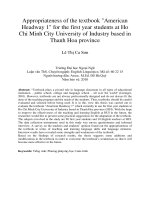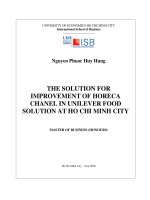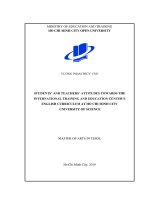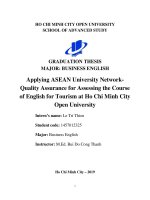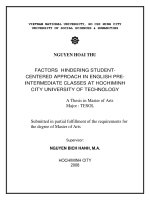Students’ perception of the use of video recordings in english speaking classes at ho chi minh city university of transport
Bạn đang xem bản rút gọn của tài liệu. Xem và tải ngay bản đầy đủ của tài liệu tại đây (6.43 MB, 104 trang )
MINISTRY OF EDUCATION AND TRAINING
HO CHI MINH CITY UNIVERSITY OF TECHNOLOGY
-------------------------
VU NGOC LONG
STUDENTS’ PERCEPTION OF THE USE OF
VIDEO RECORDINGS IN ENGLISH SPEAKING
CLASSES AT HO CHI MINH CITY
UNIVERSITY OF TRANSPORT
MASTER THESIS
Major: English Language
Course Code: 8220201
HO CHI MINH CITY, JULY 2022
MINISTRY OF EDUCATION AND TRAINING
HO CHI MINH CITY UNIVERSITY OF TECHNOLOGY
-------------------------
STUDENTS’ PERCEPTION OF THE USE OF
VIDEO RECORDINGS IN ENGLISH SPEAKING
CLASSES AT HO CHI MINH CITY
UNIVERSITY OF TRANSPORT
Submitted to
the Faculty of English Language
in partial fulfilment of the Master’s degree in English Language
By
VU NGOC LONG
Course Code: 8220201
Supervised by
TRUONG CONG BANG, Ph.D.
HO CHI MINH CITY, JULY 2022
16840 words
The thesis entitled Students’ Perception of The Use of Video Recordings in English
Speaking Classes at Ho Chi Minh City University of Transport was successfully
defended and approved on June 8th 2022 at Ho Chi Minh City University of
Technology (HUTECH).
Academic supervisor Trương Công Bằng ..............................................................
Examination Committee
1 Nguyễn Thị Kiều Thu......................................................... Chair
2 Cao Thị Phương Dung...................................................Reader 1
3 Nguyễn Thị Thu ............................................................Reader 2
4 Phạm Huy Cường .......................................................... Member
5 Nguyễn Thị Như Ngọc .................................. Secretary Member
On behalf of the Examination Committee
Chair
HCMC UNIVERSITY OF TECHNOLOGY
POSTGRADUATE INSTITUTE
___________________________
HCMC ............................. 2022
MASTER’S THESIS REPORT
Student name:Vu Ngoc Long ........................................Sex: Male..............................
Date of birth: 02/01/1988 .............................................. Place of birth: Đồng Tháp.....
Major: English Language..............................................Student code: 1941900033....
I- Thesis title:
Students' Perception of the Use of Video Recordings in English Speaking Classes at
Ho Chi Minh City University of Transport
II- Objectives and contents:
The objective of this study is to investigate UT students ‘perception on the use of
video recordings in English speaking class.
The aims of this study are:
To gain the deeper insight into the perception on the use of video recording in
English-speaking studying.
To investigate the advantages and disadvantages of Video Recordings function as
a learning tool.
III- Starting date: 20/03/2021 .....................................................................................
IV- Completing date: 20/09/2021 ...............................................................................
V- Academic supervisor: Trương Công Bằng, Ph.D.
ACADEMIC SUPERVISOR
FACULTY DEAN
CERTIFICATE OF ORIGINALITY
I certify my authorship of the Master’s Thesis submitted today entitled:
Students' Perception of the Use of Video Recordings in English Speaking Classes at Ho
Chi Minh City University of Transport
In terms of the statement of requirements for Theses in Master’s programs issued by
the Higher Degree Committee of Faculty of English Language, Ho Chi Minh City
University of Technology.
Ho Chi Minh City, ........................................................
VU NGOC LONG
RETENTION AND USE OF THE THESIS
I hereby state that I, VU NGOC LONG, being a candidate for the degree of Master
of Arts (English Language) accept the requirements of the University relating to the
retention and use of master’s Theses deposited in the library.
In terms of these conditions, I agree that the original of my master’s Thesis deposited
in the library should be accessible for purposes of study and research, in accordance
with the normal conditions established by the Librarian for the care, loan, and
reproduction for theses.
Ho Chi Minh City, ........................................................
Signature .......................................................................
VU NGOC LONG
i
ACKNOWLEDGEMENTS
I would first like to express my deepest gratitude to Dr. Trương Công Bằng, my
supervisor, for his patience, guidance, insightful advice, and constant encouragement
through the whole research process. Without his support and guidance, this thesis
would never have been completed.
I additionally like to thank my beloved family. They are an endless source of
inspiration that gave me such strength to do this research. I can not finish this study
without my wife’s encouragement, sharing and tolerance.
I would like to express my infinite appreciation to the lecturers and staff at the Ho
Chi Minh City university of technology who have wholeheartedly taught and
imparted useful knowledge and guidance to contribute to the improvement of my
thesis.
I also would like to sincerely thank Ms. Vu Thi Lan Anh who is currently the Dean
of Foreign Language Department of Ho Chi Minh City University of Transport for her
help and giving me all necessary conditions to be able to do the research.
Finally, I know this work is far from flawless. Many errors occurred. This research is
intended to make a contribution, particularly for those with an interest in related
studies, and is useful to the UT students.
.......................................................................................................................................
.......................................................................................................................................
.......................................................................................................................................
ii
ii
ABSTRACT
The perception of the students regarding the use of videos can affect their
behavior and thereby contribute to their learning achievement. In the current research,
the researcher was interested in developing and optimizing the use of video camera
in the language classes by exploring the advantages and disadvantages of using video
recordings with hope that he could find ways to help students learn English more
effectively. The investigation used a mixed method approach that included a
questionnaire and individual interviews with students. Data were gathered in a
university located in Ho Chi Minh City. Participants were first year and second year
students who were studying non-English majors studying English as an obligatory
subject. The quantitative component was a questionnaire completed by 67 students.
The qualitative component was individual interviews with 20 students who also
completed the survey. The data from students’ interviews and questionnaire provided
additional insights into students’ perceptions on the use of video recordings in their
English classes. Most students had favorable opinions towards the use of Englishlanguage video recordings. The video camera was seen as a useful tool to help their
self-evaluating. They could recognize their advantages, disadvantages, and their
behavior in studying English. However, some students took negative views on the
use of video camera. They became anxious to maximize the performance of their
English-speaking. The thesis concludes with recommendations for lecturers and
students to enhance the teaching and learning English speaking skills in universities
in Vietnam.
(241 words)
Keywords:
video
recordings,
English
disadvantages
iii
classes,
perception,
advantages,
TABLE OF CONTENTS
Certificate of originality ............................................................................................... i
Retention and use of the thesis… ............................................................................ ....i
Acknowledgements .....................................................................................................ii
Abstract… ................................................................................................................. iii
Table of contents… ....................................................................................................iv
Number of words of the Thesis ..................................................................................vi
List of tables… ...........................................................................................................vi
List of figures .............................................................................................................vi
List of abbreviations… ..............................................................................................vii
CHAPTER 1: INTRODUCTION ......................................................................... 1
1.1. Background to the study .................................................................................... 1
1.2. Problem statement ............................................................................................. 3
1.3. Aims and objectives of the study ...................................................................... 4
1.4. Research questions ............................................................................................ 4
1.5. Scope of the study ............................................................................................ 4
1.6. Significance of the study ................................................................................... 5
1.7 Definition of key terms ......................................................................................... 5
1.8 Organizations of the thesis .................................................................................... 8
CHAPTER 2: LITERATURE REVIEW ...............................................................9
2.1 Videos recording ................................................................................................... 9
2.2 Videos recording tools ........................................................................................ 10
2.3 Videos and video recordings in learning............................................................. 11
2.4 Advantages of Using Video in learning activities .............................................. 13
2.5 Challenges of Using Video Recordings in English classes ................................ 14
2.6 Speaking skill and the importance of speaking skill in learning English ........... 14
2.7 Previous Studies .................................................................................................. 17
v
2.8 Conceptual Framework ....................................................................................... 17
2.9 Summary ............................................................................................................. 18
CHAPTER 3: METHODOLOGY ........................................................................ 22
3.1 Research design ................................................................................................. 22
3.2 Research site .......................................................................................................24
3.3 Sample and sampling procedures ....................................................................... 24
3.4 Research instruments ......................................................................................... 27
3.5 Data collection procedures ................................................................................. 27
3.6 Data analysis procedures .................................................................................... 28
3.7 Validity and Reliability ....................................................................................... 28
3.8 Ethical Issue ........................................................................................................ 32
3.9 Summary ............................................................................................................. 33
CHAPTER 4: RESULTS AND DISCUSSIONS
4.1 Introduction ......................................................................................................... 34
4.2 Results ................................................................................................................. 34
4.3 Discussion ........................................................................................................... 46
CHAPTER 5: CONCLUSION
5.1 Summary of the main finding ............................................................................. 57
5.2 Pedagogical implications .................................................................................... 60
5.3 Limitations .......................................................................................................... 61
5.4 Recommendations for further research ............................................................... 63
REFERENCES ....................................................................................................... 64
APPENDICES ........................................................................................................ 64
Appendix A: QUESTIONNAIRE ............................................................................ 73
Appendix B: INTERVIEW QUESTIONS............................................................... 75
Appendix C: ENDORSEMENT FORM ................................................................. 76
Appendix E: PLAGIARISM CHECK RESULT ..................................................... 77
v
THE NUMBER OF WORDS OF THE THESIS
Number of
Chapter
words
Chapter 1
2213
Chapter 2
3838
Chapter 3
2973
Chapter 4
5780
Chapter 5
2036
Total
16840
vi
LIST OF TABLES
Table 1
The affective and effective aspects
Table 2
Using video recordings in learning speaking English and the
development of English-speaking skills.
Table 3
The increasing students’ motivation and focusing on learning process
Table 4
Long-term psychological problems and personal factors
Table 5
Number of years in studying English
Table 6
Reliability Statistics of the students’ perception
Table 7
Item-Total Statistics of the students ‘perception
Table 8
Descriptive Statistics of the students’ perception
Table 9
Reliability Statistics of the advantages and disadvantages
Table 10
Item-Total Statistics of the advantages and disadvantages
Table 11
Descriptive statistics of the advantages and disadvantages
vi
LIST OF FIGURES
Figure 1: The conceptual framework
vi
LIST OF ABBREVIATIONS AND SYMBOLS
EFL
English as a foreign language
ELT
English Language Teaching
ESL
English as a Second Language
FHD
Full High Definition
GE
General English
HD
High Definition
IELTS
International English language Testing System
MALL
Mobile-assisted language learning
M-learning
Mobile Learning
PVR
Peer video recording
SVCs
Short Video Clips
TESOL
Teaching English to Speakers of Other Languages
UT
Ho Chi Minh City University of Transport
VRs
Video Recordings
vii
CHAPTER 1
INTRODUCTION
This chapter includes background material on the topics that are to be discussed and
analyzed, giving the inspiration for the current study and the overall objectives of
research.
1.1 Background to the study
English is currently popularized in at least 80 countries worldwide as the official
language with more non-native users than native ones (Galloway & Rose, 2015).
Galloway & Rose (2015) said English was a global phenomenon, resulting in greater
interaction with foreign languages, and with a significant increase in the English
speaker population. There is an enormous number of visitors who speak English.
Consequently, the objective of English as a worldwide English has relatively
reformed and requires a reinvention of educational supplies and resources,
particularly in nations with old-style approaches (Sharifian, 2009). To encourage
engagement to learn English conversation, offering students the opportunity to
concentrate not just on the language, but on the learning processes, to explore people's
perspective as a central element in learning and to coordinate the learning process
with the use of language outside the classroom (Prabhu, 1987).
In addition to the need for social skills and the need for students to use language
outside their school, language learners have to find ways to expand communication
in the target language besides the classrooms (O'Malley & Pierce, 1996). Video
development is one of the areas that educators and scholars have gained significant
exposure.
The usual use of new technologies in English education involves the use to the
most successful attainment of the desired objectives technological, visual approaches,
1
instruments, materials, facilities, programs and techniques for teaching English. The
Merriam-Webster dictionary explains how expertise of a certain field or the peculiar
features of a certain field of work can be used in the realistic way. Many scholars are
involved in studies to identify the types of technology used and how valuable they
are for language education. Golonka et al. (2014) presented details on the efficiency
of language research technology use. The belief that students prefer to participate in
more mobile online activities like viewing videos on Youtube than teaching-centric
activities, is shared by Tran Mai Phuong (2017). Mobile technology is one of the most
popular inventions today and one of the most interested among young learners today.
(Gromik, 2015). Mobile devices have recently been introduced into learning more
frequently (Godwin-Jones, 2018). In teaching English, the widespread use of
smartphones has turned conventional teaching and learning approaches into mobile
apps. A variety of applications can be downloaded for language learners with a simple
internet connection. Smart device mobility and accessibility make it possible to
access learning opportunities.
In order to systematically optimize English teaching and the relation to English
school students, educational industry needs to continue to keep pace with the global
technical upheaval with the adoption of emerging skills such as computerization,
multimedia tools, mobile phone and Internet connections, audio and visual properties
and mass media.
1.2 Statement of the problem
In the education system of Vietnam, English is an obligatory subject both
secondary and tertiary. In Vietnam, most non-English majors learn English to pass
the exams (Hoang Van Van, 2008). Generally speaking, students who do not major
in English are not interested in studying the language for objectives like
communication, international exchange, or their ultimate career goal (Ngo Thi Thu
Huong, 2015). Some see English as a tool for more attractive and profitable jobs
2
following graduation; a small number of others need a strong English understanding
to study not further in Vietnam or in an English-speaking country.
Buck. J. L, McInnis. E & Randolph.C (2013) argued that educational
technological advances such as computer apps and smartphones would draw the
interest of students. There is much uncertainty about the use of smartphone apps by
university students to effectively study English even they are equipped with advanced
educational tools such as: computers, projectors, Wi-Fi-free internet connection. The
issue might not be from only students’ approaches in studying but also from the
implementation of teaching methods in UT.
Mobile-assisted language learning (MALL) is nothing unknown for EFL
teachers, although MALL has been popularized in universities to enhance language
learning skills. It does not seem unusual for EFL teachers. The perception of the
student towards this is still not so clear that it must be examined and observed
carefully. On the contrary, Vietnamese students are given more options and prospects
for advanced research methods by exploding handheld devices with lots of modern
and advanced technology. Applications deal with English learning are numerous, and
the acquisition of materials and service is better for university students. But nonEnglish majors are still very unfamiliar, especially UT students. They were not taught
to use the useful Mobile Devices applications in the field of foreign language
learning, particularly the video recordings. Empirical study on those topics is also
important for the perception and discovery of the use of film, camera and video
recordings in English classrooms.
1.3 Aims and objectives of the study
The aim of this study, therefore, is to investigate UT students ‘perception on the
use of video recordings in English speaking class.
The objectives of this study are:
3
To gain the deeper insight into the perception on the use of video recordings in the
learning of English-speaking skills.
To investigate the advantages and disadvantages of video recordings as a learning
as a tool in their learning of speaking skills.
1.4 Research questions
To achieve these two aims, the study is to answer the two questions:
1. What is students' perception towards the use of video recordings in the Englishspeaking classes at Ho Chi Minh city University of Transport?
2. What are the challenges that students think they have when learning English
speaking with Video Recordings?
1.5 Scope of the study
The study was conducted at Ho Chi Minh City University of Transport. It could
not be conducted among the whole population of The University of Transport due to
the time limit and approval restrictions. This study was done to only 67 non-English
majors in their English-speaking practices use video recording tools in mobile
devices. The fresh and sophomore research participants were appointed by the dean
of the English department of random faculty.
1.6 Significance of the study
Theoretically, findings from this study will hopefully offer an essential insight to
increase students' enthusiasm in the use and practice in classrooms of the smartphone
app in general and video capturing resources in person.
This study also offered analytical proof in defining the difficulties of conventional
instruction, which essentially slowed or hampered the process of English learning and
therefore helping to find various solutions for their modification by technical methods
and instruments.
4
Practically, utilization of video recordings in English studying could bring light on
the question of learning English speaking, not just for 80 students assigned in this
study, but also for all students at the University of Transportation with a view to
helping students realize the studying English with common state-of-the-art
technology.
1.7 Definition of key terms
1.7.1 Definition of Mobile Learning (M-learning).
Various scholars' viewpoints on the term "M-learning" were gathered. Mobile
learning, on the other hand, is considered that to take place using mobile devices
like smartphones and tablets as instructional resources (Online Cambridge
Dictionary). Mobile learning, according to Sharples (2006), is the utilization of
mobile device technical developments. According to Ngo Tan Vu Khanh (2014)
and Nguyen Ngoc Vu (2016), mobile learning (M-learning) is a learning approach
that allows students to access knowledge from anywhere, at any time, and with
ease, all while using a mobile device. Within the framework of this research,
mobile learning is described as learning resources embedded in mobile devices
that enable students to learn anywhere, at any time.
1.7.2 MALL - Mobile Assisted Language Learning.
MALL is a recent language learning movement that is accompanied by
scientific and technological innovation. Mobile language teaching and learning is
a modern and rapidly expanding process. MALL has new and creative means of
teaching and studying English. Kukulska-Hulme (2006) describes the use of
mobile technologies in learning as having portable and unique advantages.
According to Miangah and Nezarat (2012), MALL is the use of cell phones in
language learning activities. This analysis would look at the camera built into a
5
portable device, which is one of many useful devices used for learning to speak
English.
1.7.3 Perception
Perception, according to Altman et al. (1985), is characterized as the process by
which people pick and group stimuli in order to perceive them meaningfully. To
put it another way, perception refers to how people perceive their surroundings.
Perception is a coherent interpretation from physical exertion that we feel or hear,
as described by Warga (1983). Our senses detect a form of physical energy, which
is translated into a stimulus by the brain. The sense is thus extracted from the
synthesis of stimuli.
Based in both meanings, it is reasonable to believe that everyone has a unique
perspective on what he or she encounters or thinks in the world. Distinct persons
may perceive the same thing or experience differently, resulting in different
behavioral responses or attitudes. Perception, as it relates to this study, is the way
students feel, think about, and perceive something, in this case, the usage of video
recordings in English speaking lessons.
According to Leontiev (1981), perception is the mechanism by which the presence
of objects and phenomena is mirrored in a person's mind and consciousness.
Perception is supported by sensory organs such as the pupils, ears, mouth, nose,
and skin. It means that an individual uses sensory organs to actively sense objects,
environments, and events around them.
The existence of perception starts with stimulus. Stimuli are bodily energies that
strike sensory receptor. The sensors are the organs of the body that send signals to
the brain, such as the ears, eyes, nose, and skin. Knowledge would be generated as
a result of the chosen stimulus. The details received would be arranged and
processed by the brain. Sensation, or the translation of external energy, is the
6
interpretation of information. The brain then transforms the details into meanings
after it has been translated. Perception is the outcome of the meaningful translation
of information. Then, behavioral responses towards the perception exist.
The four aspects stated above that impact someone's perception of a situation are
stimulus selection, organization of stimuli, context, and self-concept (Altman et
al., 1985). People can sense, coordinate, and understand the stimulus meaningfully
after receiving the selected stimuli, which may be in the case of physical or mental
stimuli. People will react to stimuli in the form of a behavioral reaction or an
attitude as a reaction.
1.7.4 The situation of students owning technological devices.
The statistics portal projection indicates that between 2015 and 2020 the total
number of smartphones worldwide demonstrates that mobile phone users were
increasing significantly from just 4.15 billion in 2015 to 4.78 billion by 2020, and
in 2021 the number of users is projected to increase to 5.07 billion. (Gu. T, 2019).
People do not utilize their mobile phones for basic functions such as dialing
numbers or making phone calls, neither send nor read texts with interest. Mobile
phones are now more than simply playing, but mobile technology has now grown
expressively. Together with suitable software, which is loaded in the mobile
phones, individuals may use their mobile phones for working, resting, connecting,
and learning, which is primarily focused on the educational area, due to the
advancement of the internet. According to Godwin-Jones (2018), smartphones
with internet or wireless connections, such as smartphones and tablets, are
becoming an essential component of students' daily lives. Students may now easily
contact their instructors, friends, and classmates in person through free calls,
messages, and emails. Students can look for information fast without having to
turn their laptops. This technology is becoming more widely available and less
expensive, providing additional educational options. According to a Harris Poll
7
(2015) nationwide study, nine out of 10 college students use a laptop or
smartphone on a daily basis. According to the survey, every university student
possesses a laptop or smartphone.
1.8 Organizations of the thesis
The study consists of five chapters:
The introduction of the study, the objective of the research, the research questions,
the importance of the investigation, the restrictions, the delimitations, and the
structure of the research are all covered in the first chapter.
Chapter two is the literature review, providing the theoretical background to the
study beginning with some common types of technology which can be used in the
English language classrooms. The advantages and disadvantages of using video
recording in learning English are introduced in this chapter. Finally, the notions of
using video recordings in learning English to investigate students’ perceptions are
examined by the researcher.
Chapter three describes the methodology, research questions, the research design,
the data collection including the instruments and the procedure of the data collection,
data analysis, and reliability and validity.
Chapter four provides the research findings and discussion, present the analyzed
data, the findings of the study based on the statistic tables and graphs, and discussion
the findings.
Chapter five presents the conclusions and recommendations, mentions some
implications and recommendations for administrators, teachers and students of using
video recordings effectively learning English and suggestions for further research.
Finally, the conclusions of the study are also given at the end of the chapter.
8
CHAPTER 2
LITERATURE REVIEW
To provide a background of the study, this part describes a theoretical framework
for designing and analyzing data. This part begins by reviewing theories of video
and video recordings in learning followed by advantages and disadvantages of video
recordings.
2.1 Video recording
Video recording is the media which is used in teaching speaking by recording the
students’ speaking performances. Video recording has the ability to self-reflect and
it is widely recognized as the desirable learner attribute that can induce the deep
learning (Chau and Cheng, 2009). Odhabi & Nicks-McCaleb (2009) say that media
technologies allowed the users to record audio and video by using video cameras in
lecture halls and other learning environments. Dali (2012) argues that video recording
is favorably perceived media especially in providing feedback.
The use of video-recording on students’ speaking in language learning offers several
advantages: First, students can watch and see themselves and their fellow friends’
performances. Second, teachers can use video to help students become better speakers
in English (Lonergan, 1984; Tomalin & Stempleski, 1990). In addition, students have
the opportunity to view the recording on video more than once.
Thus, recording students’ speaking performances allowed the teachers or the students
to play and replay the video recording in many times. Hence, the students did selfevaluation of themselves as well as their fellow friends. As a consequence, the
students became self-critical, because they can see their problems and trace their
improvements. And when the video recording showed to many people, there were
some recommendations and suggestions to the presenter.
9
Broady (1998) explains that because of video, the learners have a motivation to
communicate with each other and with the teacher. Related to this opinion, the
example can be seen in the speaking class using video recording, the students were
able to comment their friends’ performances and asked the teacher for the additional
comments and suggestions in evaluating session. This situation showed the good
interaction between students and teachers.
2.2 Videos recordings tools
In order to record students’ speaking performances, the teacher needed a certain
material or tools to make a very high-quality video as a good data information that
they can use it as a source to teach and evaluate students’ speaking performances.
Derry (2007) suggested several tools that can be used to make a very high quality of
video with some additional by the researcher.
The tools as follows:
1. Camera Phone
There are several numbers of activities which can be facilitated by Mobile
Assisted Language Learning (MALL). Camera phone is one of the parts of
MALL. It utilized camera inside mobile phone for educational setting. The
researcher used this kind of recording tool to record students’ speaking
performances. Camera phone also can be used by the students to create video
recording task. Korsvold and Ruschoff (1997) mention that there are two types
of video tasks, they are video feedback and video project. Video feedback is the
task that allows the student to record their activity. Besides, video project works
refers to the use of video as a medium for making a documentaries and news
items.
2. Camera DV
A mini-DV camera should have an image stabilization feature (for hand-held
use) and true stereo (left/right) audio separation. A rechargeable, long-life
battery (i.e., one that will last more than three hours) is also highly desirable. A
10
good quality, screw-on wide-angle lens is also very useful, particularly when
the researcher is filming in restricted spaces. Using a camera into which tapes
can be loaded while the camera is attached to a tripod.
3. Microphones
Several types of mikes are useful. Almost any external mike will do a better job
of sound capture than will the camera’s built-in mike.
4. Tripod
By attaching the camera to a good quality tripod, the teachers are able to
smoothly pan, zoom and lock the camera in a fixed position when the teachers
were busy or did the other things.
5. Earphones
This tool is used to check the sound with earphone at the beginning of a
recording and again periodically while recording. A video recording with weak
audio will be checked later.
6. Gaffer’s Tape
Gaffer’s tape (black, cloth tape) allowed the teachers to tape down the legs of
the tripod without leaving marks on furniture or other anchoring objects.
7. Camera Bag
A durable, spacious camera bag allowed the teachers to carry the entire rig in
one hand while carrying a tripod in the other.
2.3 Videos and video recordings in learning
In English teaching and studying, one approach to discuss the medium is to
document paralinguistic behavior that contributes to the understanding of the target
language by the learner. This is known as an audio-visual compilation and sequence
of messages. "Video" may only be the use of common films in the video for content
or the use of smaller broadcast material, which are used in whole and in part, in
language learning. Short documentary and TV advertising is an example of
transmitted material for the provision of information and teaching structures. "Video"
11
